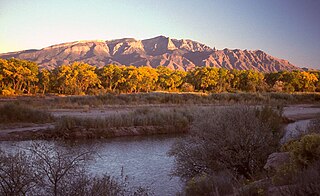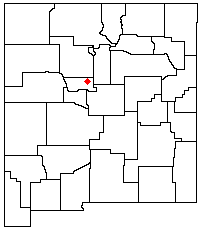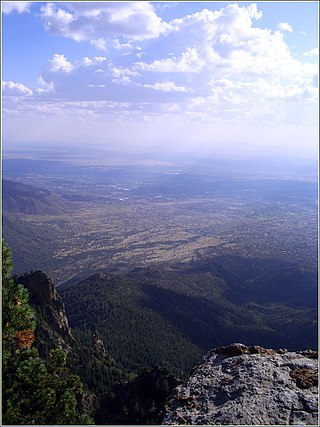Related Research Articles

Albuquerque, also known as ABQ, Burque, and the Duke City, is the most populous city in the U.S. state of New Mexico. Founded in 1706 as La Villa de Alburquerque by Santa Fe de Nuevo México governor Francisco Cuervo y Valdés, and named in honor of Francisco Fernández de la Cueva, 10th Duke of Alburquerque and Viceroy of New Spain, it served as an outpost on El Camino Real linking Mexico City to the northernmost territories of New Spain.

Placitas is a census-designated place (CDP) in Sandoval County, New Mexico, United States. As of the 2010 census, its population was 4,977. It is part of the Albuquerque Metropolitan Statistical Area.

The Long Walk of the Navajo, also called the Long Walk to Bosque Redondo, was the deportation and ethnic cleansing of the Navajo people by the United States federal government and the United States army. Navajos were forced to walk from their land in western New Mexico Territory to Bosque Redondo in eastern New Mexico. Some 53 different forced marches occurred between August 1864 and the end of 1866. In total, 10,000 Navajos and 500 Mescalero Apache were forced to the internment camp in Bosque Redondo. During the forced march and internment, up to 3,500 people died from starvation and disease over a four-year period. In 1868, the Navajo were allowed to return to their ancestral homeland following the Treaty of Bosque Redondo. Some anthropologists state that the "collective trauma of the Long Walk...is critical to contemporary Navajos' sense of identity as a people".

The Sandia Mountains are a mountain range located in Bernalillo and Sandoval counties, immediately to the east of the city of Albuquerque in New Mexico in the southwestern United States. The mountains are just due south of the southern terminus of the Rocky Mountains, and are part of the Sandia–Manzano Mountains. This is largely within the Cibola National Forest and protected as the Sandia Mountain Wilderness. The highest point is Sandia Crest, 10,678 feet (3,255 m).

Rudolfo Anaya was an American author. Noted for his 1972 novel Bless Me, Ultima, Anaya was considered one of the founders of the canon of contemporary Chicano and New Mexican literature. The themes and cultural references of the novel, which were uncommon at the time of its publication, had a lasting impression on fellow Latino writers. It was subsequently adapted into a film and an opera.

The KiMo Theatre is a theatre and historic landmark located in Albuquerque, New Mexico on the northeast corner of Central Avenue and Fifth Street. It was built in 1927 in the extravagant Pueblo Deco architecture, which is a blend of adobe-style Pueblo Revival architecture building styles, decorative motifs from indigenous cultures, and the soaring lines and linear repetition found in American Art Deco architecture.

The Sandia–Manzano Mountains are a substantial mountain area that defines the eastern edge of the middle Rio Grande Valley of central New Mexico. They are not only an attractive backdrop to greater Albuquerque, the largest metropolitan area in New Mexico, but their elevation changes provide recreational opportunities including winter skiing and cool summer hiking or picnicing, as compared to the desert grasslands, foothills, and Rio Grande Valley below. The entire mountain chain comprises three parts, arranged north to south: the Sandia Mountains, the Manzanita Mountains, and the Manzano Mountains. The Manzanita Mountains are a series of low-lying foothills that separate the Sandias from the Manzanos.

TWA Flight 260 was the Trans World Airlines (TWA) designation for a flight from Albuquerque, New Mexico to Santa Fe, New Mexico. On February 19, 1955, the 40-passenger Martin 4-0-4 prop plane used by TWA for that route crashed into the Sandia Mountains. Its deviation from the normal flight path, initially believed to be the result of pilot error, was revised to "unknown" given that the contribution of other factors could not be definitively ruled out.

Sandia Crest, also known locally as Sandia Peak or simply as the Crest, is a mountain ridge that, at 10,679 feet (3,255 m), is the highpoint of the Sandia–Manzano Mountains, and is located in the Sandia Mountains of Bernalillo County, New Mexico, United States. Instead of a true summit or topographic peak, this range climbs to a long ridge line. To the east, the range slopes down from the Crest and merges into the plains below. On the west side of the Crest is a cliff; the range dramatically drops over 4,000 feet in elevation over 2 miles of horizontal distance to the Rio Grande Valley and city of Albuquerque below. It is within the Sandia Ranger District of the Cibola National Forest. The Crest features a viewing area with a shop and visitor center, telecommunications transmitters, the popular La Luz Trail, the Sandia Mountain Wilderness, and the summit of Sandia Peak Ski Area and the Sandia Peak Tramway, which is the longest aerial tramway in the Americas.

The Manzano Mountains are a small mountain range in the central part of the U.S. state of New Mexico. They are oriented north–south and are 30 miles long. The center of the range lies due east of the town of Belen. The name "Manzano" is Spanish for "apple"; the mountains were named for apple orchards planted at the nearby town of Manzano.

Tijeras Canyon is a prominent canyon in the central part of the U.S. state of New Mexico. It separates the Sandia Mountains subrange to the north from the Manzano Mountains subrange to the south. These subranges are part of the larger Sandia–Manzano Mountains; Tijeras Canyon forms a pass through this range. Elevations along the bottom of the canyon range from 5,600 feet (1,700 m) to 7,000 feet (2,100 m) above sea level. The canyon drains to the west, into a large dry wash known as Tijeras Arroyo, which runs through Kirtland Air Force Base, passes just south of the Albuquerque International Sunport, and then joins the Rio Grande. The arroyo heads at the historically important pass, and this pass and the entire canyon are traversed by Interstate 40, following the path of historic U.S. Route 66.

Douglas Kent Hall was an American writer and photographer. Hall was a fine art photographer and writer of fiction, poetry, nonfiction, essays, and screenplays. His first published photographs were of Jimi Hendrix and Jim Morrison, and his first exhibition of photographs was at the Whitney Museum of American Art.

The Albuquerque Metropolitan Statistical Area, sometimes referred to as Tiguex, is a metropolitan area in central New Mexico centered on the city of Albuquerque. The metro comprises four counties: Bernalillo, Sandoval, Torrance, and Valencia. As of the 2010 United States Census, the MSA had a population of 887,077. The population is estimated to be 923,630 as of July 1, 2020, making Greater Albuquerque the 61st-largest MSA in the nation. The Albuquerque MSA forms a part of the larger Albuquerque–Santa Fe–Las Vegas combined statistical area with a 2020 estimated population of 1,165,181, ranked 49th-largest in the country.
Craig Varjabedian is a fine-art photographer who explores the back roads of the American West, making pictures of the unique and quintessential. He shares stories of the land and the people who live on it, one photograph at a time. Moving from Canada to the United States in 1970, he currently lives in Santa Fe, New Mexico.
Queen is an unincorporated community in Eddy County in southeastern New Mexico, in the southwestern United States. Although it currently has a population of around 50, it was formerly considered a ghost town. Located in the foothills on the east side of the Guadalupe Mountains, in the southern Lincoln National Forest, it flourished in the early 20th century as a ranching center. Queen is located alongside NM Route 137, about 27 mi southwest of Carlsbad.
El Rito,, is an unincorporated community in Rio Arriba County, New Mexico, United States. Its elevation is 6,875 feet (2,096 m).

The Albuquerque Basin is a structural basin and ecoregion within the Rio Grande rift in central New Mexico. It contains the city of Albuquerque.

Nutt is an unincorporated community in Luna County, southern New Mexico, in the American Southwest. It is located nineteen miles southwest of Hatch on NM 26 at the intersection with NM 27.

Mysterious New Mexico: Miracles, Magic, and Monsters in the Land of Enchantment is a 2014 collection of thirteen investigations conducted by author Ben Radford into cases involving claims of the paranormal occurring in or with significant connections to New Mexico.
The Jicarilla Mountains, also called Sacremento Mountains, are a mountain range in Lincoln County, New Mexico in the southwestern United States, south to the Guadalupe Mountains, one of the highest peaks in the territory and a placer mining district in New Mexico. The Jicarilla Mountains were named after the Jicarilla Apache Nation. The Sacramento Mountains lie to the southwest.
References
- 1 2 3 4 5 6 Julyan, Robert (1998). The place names of New Mexico (2nd ed, rev ed.). Albuquerque: Univ. of New Mexico Press. ISBN 978-0-8263-1689-9.
- 1 2 3 Smith, Mike (2006). Towns of the Sandia Mountains. Images of America. Charleston, SC: Arcadia Pub. ISBN 978-0-7385-4852-4. OCLC 76884067.
- 1 2 3 4 Anderson, Kay Kind Bradley (February 6, 2024). As Best I Can Remember: What's a nice Jewish girl from Philadelphia doing in a place like this? (1st ed.). Outskirts Press. ISBN 9781977264749.
- 1 2 Matthews, Kay (2015). Culture clash: environmental politics in New Mexico forest communities: a memoir, 1970-2000. Santa Fe: Sunstone Press. ISBN 978-1-63293-005-7.
- 1 2 Fairfield, Richard (1972). Communes USA; a personal tour. Baltimore, Md: Penguin Books. ISBN 978-0-14-003489-9.
- 1 2 Price, Roberta; Miles, George, eds. (2010). Across the great divide: a photo chronicle of the counterculture. Albuquerque: University of New Mexico Press. ISBN 978-0-8263-4957-6.
- 1 2 "Flashbacks". www.newmexicomagazine.org. 2013-03-08. Retrieved 2024-03-29.
- ↑ Miller, Timothy (2012). "New Mexico's Communal Settlers". New Mexico Historical Review.
- ↑ Hovey, Kathryn (2005). Anarchy and community in the new American West: Madrid, New Mexico, 1970–2000. Albuquerque: University of New Mexico Press. ISBN 978-0-8263-3446-6.
- 1 2 "Will the little places of New Mexico survive economic growth?". NM Political Report. 2018-12-04. Retrieved 2024-03-29.
- 1 2 "Healing Clan". NM Healthy Soil Working Group. 2022-04-18. Retrieved 2024-03-29.
- ↑ Scurlock, Dan (1998). From the Rio to the Sierra: An environmental history of the Middle Rio Grande Basin (Report). Ft. Collins, CO: U.S. Department of Agriculture, Forest Service, Rocky Mountain Research Station. doi: 10.2737/rmrs-gtr-5 .